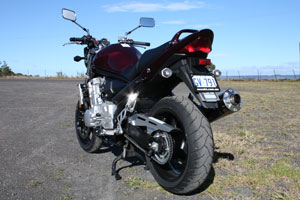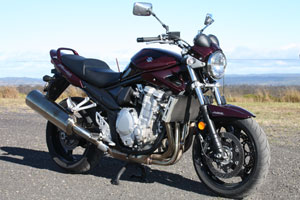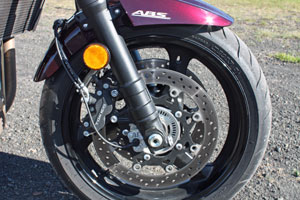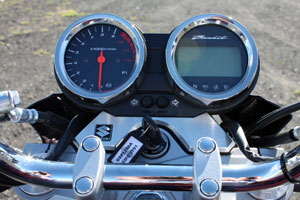MotoOnline.com.au puts Suzuki’s 2009 model Bandit 1250 ABS through its paces out on the open roads.

SUZUKI BANDIT 1250 ABS SPECIFICATIONS
ENGINE
Engine type: Four-stroke, four-cylinder, DOHC, 16-valve, liquid-cooled
Bore x stroke: 79 x 64mm
Displacement: 1255cc
Compression ratio: 10.5:1
Transmission: Six-speed
Power (claimed): 105hp
Torque (claimed): 83ft-lbs
CHASSIS
Frame type: Steel tube-frame
Front suspension: 43mm Telescopic, coil spring, oil damped forks
Rear suspension: Link type, coil spring, oil damped, single shock absorber
Wheelbase: 1485mm
Wheels (front/rear): 17 x 3.50 / 17 x 5.50
Tyres (front/rear): 120/70 ZR17 / 180/55 ZR17
Brakes (front/rear): Tokico duel 310mm discs, four-piston calipers / Nissin 240mm single disc and piston caliper
DIMENSIONS
Weight (claimed): 251kg
Seat height: Adjustable 785/805mm
Fuel capacity: 19L
PURCHASE DETAILS
Price: $12,290 ($11,790 for non-ABS version)
Colour options: Cherry Red
Test bike from: Suzuki Australia (www.suzukimotorcycles.com.au)
I’m cruising through some tight and twisty roads, winding my way towards a couple of sections that are more wide open, but enjoying every step along the way on the Suzuki Bandit 1250 ABS.
Almost from the outset it’s obvious that the powerful liquid-cooled, 16-valve, DOHC, four-cylinder, four-stroke, 1255cc engine loves to grunt from corner to corner, but in the same note it’s also clear that the chassis would be in its element on the open roads.
You see, this is where the strong points of this bike meet in the middle, because while the engine is great on acceleration and the chassis works brilliantly at speed, both aspects of the motorcycle do the complete opposite tasks very well also – the motor ticks along nicely at speed and the handling is more than capable in the twisties.
The Bandit 1250 is available in four different versions, with the anti-lock braking-equipped naked model ($12,290) the bike that we have on test this week, while it also comes in a non-ABS naked model ($11,790).
If you’re looking for a bit more wind protection over longer distances than there’s the half-faired 1250S models in both ABS ($12,790) and non-ABS ($12,290), offering a wide variety of a very solid base package – all in a very affordable price range no matter what your selection is.
Quality components and a high-powered engine makes this motorcycle a steal in the modern age that we live in, and the naked model that we’ve got our hands on is perfect for the weekend traveller or even the weekly commuter.
The lack of windscreen gets a little chilly as the sun goes down in these cold winter months, so having the option for the half-faired S model is a great one if you’re looking to log extra miles and want to avoid the wind.
There are ample tie-down points around the pillion seat at the rear if you’re looking to carry some baggage, while top cases are available for well under $400 in the accessories catalogue if you’re looking for a better fit for your luggage.
Coming in a Cherry Red colour, the naked bike that we are testing features a mix of old school looks with modern touches, with the large round headlight and cannon exhaust definitely specifying its sports tour status with an edge.
Tall rectangular mirrors standout high, proving perfect for rear vision and allowing you to see what’s behind without a worry in the world.
It has laid back handlebars and a long adjustable (20mm in height) seat, both of which make the Bandit ultra comfortable while remaining sporty enough to extract its performance capabilities.
Your better half will be happy to know that the pillion seat is also roomy, although I must admit that I never did ride the Bandit with anyone doubling up in my couple of weeks with it.
Performance wise you will be struggling to outdo the Bandit out on the street, with the previously mentioned mix of power and handling giving me great satisfaction each time I climb aboard for more kays.
The chassis features a classic tube-frame, with the rake and trail developed to create a balance of sharp handling and cruising, while front forks with 43mm-stanchion tubes and a single rear shock absorber have adjustable spring-preload.
I find it best to ease into the corners and to select my line before really powering out hard as the bike grips to the surface and holds its line well once past the apex of corners.
Its weight means that you have to be precise in your movements under braking and when cornering, but the flow around long sweeping bends is where I enjoy the bike’s handling characteristics the most.
In the braking department there are duel 310mm front disc brakes that have four-piston Tokico calipers, while the rear has a Nissin 240mm single disc and piston caliper set up – with the ABS technology on this model providing that extra confidence to squeeze the brakes hard in an emergency stop.
With a bike that weighs in at 251 kilograms it’s amazing how quickly you can pull up to a halt from high speed with the ABS system, and the lack of pulsating through the lever unless you really pull up in a hurry makes the brakes feel normal in standard riding circumstances.
Three-spoke cast-aluminium wheels fitted with Dunlop Sportmax D218 tyres are standard equipment, with the tyres heating well to offer balanced grip with plenty of feedback – especially in the rear – throughout my time on the Bandit.
Power is possibly my favourite thing about the Bandit 1250, especially the way that the six-speed gearbox allows you to rev the engine in low gears or idle along in a higher gear with low revs.
Suzuki’s Dual Valve Throttle (SDVT) fuel injection system offers crisp fuelling and throttle response, which adds to the power range that I can use anywhere between 3000rpm all the way to the tachometer’s redline showing at 9500rpm.
I hardly ever ride it in the high revs though, preferring to use the torquey part of the output from around 3500rpm to 6500rpm, which works perfectly if you click it up a gear higher and take advantage of its cubes.
Another advantage of using the engine low in its rev range is that the gears shift smoother, but I find it best no matter what to use a slight amount of clutch action on both up and down shifts for the best results.
The engine revs low at cruising speed on the freeway, and vibration is almost non-existent due to the secondary balancer shaft in the motor.
Despite its capacity, the muffler makes the bike very quiet whether you’re revving it hard or rolling along.
Speaking of the dash, it’s simple yet effective, featuring two round instrument bodies that have an analogue tachometer, LCD digital speedometer, trip meters, fuel gauge and clock, and also LED indicator lamps.
There are just two buttons (select and adjust) in the middle for operation purposes, making it easy as can be to toggle through the limited options.
The LED fuel gauge is a handy addition, especially for those who like to tour, allowing you to see exactly how much juice you have left, and it takes many kilometres for the 19-litre tank to run dry.
Overall you’d have to say that the value for money is the clear standout on a great performing bike like this, the Bandit 1250 ABS packing a heap of quality in a motorcycle with a varied range of uses.
And for just $500 more for the ABS version over the S model, you’d be hard-pressed to move past that added safety feature alone.










Newsletter